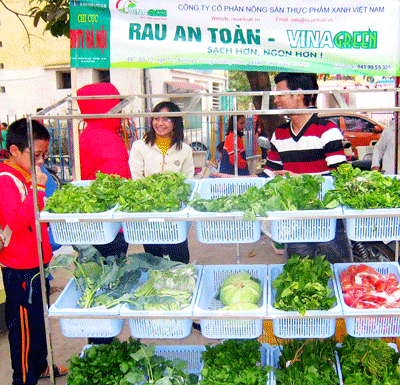
According to the Department of Plant Protection under the Ministry of Agriculture and Rural Development, since the beginning of the year till now, out of 415 randomly collected samples of vegetables and fruits from markets, 105 have tested with high content of chemical fertilizers.
Because there is no procedure for marking the origin of agricultural produce, the department cannot trace the farms growing the produce and thus cannot penalise them.
Amid news that certain vegetables contained insecticide and toxic chemicals fertilizers, concern was raised by many housewives.
Hanoi consumes 1,500 tons of vegetables each day while other provinces also have a huge demand for fruits and vegetables.
Nguyen Manh Hung, deputy chief of Vietnam Standards and Consumer Association (VINASTAS), said nearly 90 percent of consumers consider healthy vegetables as the most important ingredient in their meal and most customers agree to pay a higher price for guaranteed safe vegetables.
Currently, many areas in the country such as Hanoi, Sa Pa in the northern province of Lao Cai, Tam Dao in the northern province of Vinh Phuc, the northern province of Hai Duong, the central highlands town of Da Lat and Ho Chi Minh City, grow many different varieties of safe vegetables.
As per regulations, safe vegetables are grown under strict supervision on fields and there is an effort to minimize excessive use of insecticides and chemical fertilizers. Wholesale markets and supermarkets also do not accept vegetables grown under excessive use of chemicals; hence the price of safe vegetables is higher than normal unchecked vegetables.
According to the Research Institute of Fruits and Vegetables under the Vietnam Academy of Agricultural Sciences, as farmers cannot sell directly from farms, they are currently facing huge losses.
Only 15-20 percent of their produce is consumed through markets and stores that sell at a higher price, while similar unsafe vegetables are readily available in traditional markets. This has caused farmer to lose interest in growing safe vegetables.
Consumers are turning their backs on safe vegetables, as they cannot distinguish between safe or unsafe produce and related agencies have not yet introduced any certificate to label safe vegetables.
Meanwhile, unscrupulous traders have taken advantage of the high price of safe vegetables to sell unchecked vegetables at the same price. Related agencies have discovered many such cases and have even fined them for frauding customers.
It is high time that a transparent mechanism is set up by which customers and farmers can check and identify safe agricultural produce. Better supervision should be stepped up and heavy fines implemented on unscrupulous traders.
SGGP